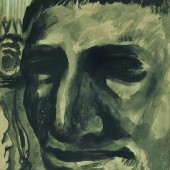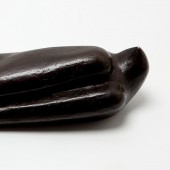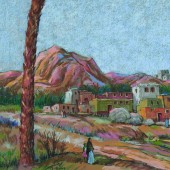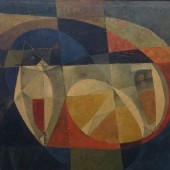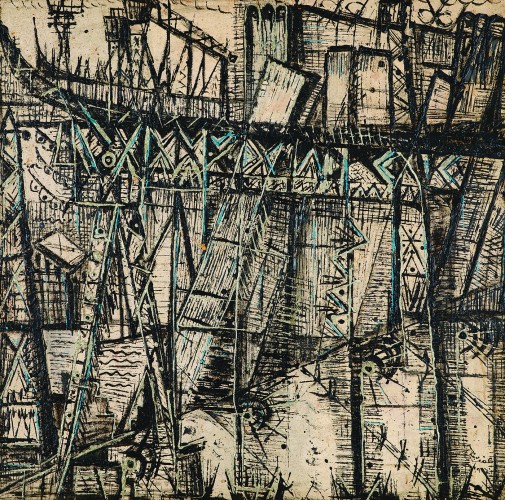
The sister of the diplomat and artist Mohammed Naghi, Effat was equally prodigious in her production of art works and outlived her brother to witness the construction of the new Aswan Dam. Her abstracted rendering of the Aswan Dam project offers an expressionist tone that depicts the complex scaffolding with its wooden and steel beams and ties. In this work, the choice of painting on wood provides a more direct reference to the material of the scaffolding itself. The work was likely part of a general commission for artists and writers, including her husband Saad El-Khadem, to document the construction of the Aswan Dam from the late 1950s until the mid-1960s.
In The High Dam, the structure is seemingly devoid of any living person. From a ground level vantage point, the viewer gazes up at the scaffold comprising pulleys and cranes and mechanical forms. The haphazard structure of tilted blocks and trusses appears on the verge of collapse and the viewer is left questioning whether its apparent frailty is intended to celebrate its achievement or point at the incomplete and tenuous nature of its construction.
The paintings and assemblages of Effat Naghi invoke traditional folklore, myth, magic and astrology. Hailing from an aristocratic family of esteemed artists, Naghi received encouragement from her influential older brother Mohammed at a young age. In 1947, she attended Rome’s Egyptian Academy to study frescos and mural painting, while in the mid-1950s she spent time researching magical rites and astrology at the Great Library of Cairo. Among a selection of artists chosen to observe and render the construction of Egypt’s High Dam in the 1960s, Naghi documented the ancient sites of Nubia before they were submerged under Lake Nasser. Exhibiting her work in Egypt and Europe, Naghi was awarded a full-time artist’s scholarship by the Ministry of Culture in 1973. In 2001, a museum dedicated to the display of her works opened in Heliopolis, Cairo.
كانت عفت ناجي، شقيقة الدبلوماسي والفنان المعروف محمد ناجي، فنانة استثنائية تماماً كأخيها في الأعمال الفنية التي تقدمها، وقد عاشت بعده لتشهد بناء سد أسوان الجديد. ويقدم عملها التجريدي لمشروع سد أسوان صيغة تعبيرية تصوّر السقالات المعقدة مع عوارضها وروابطها الخشبية والفولاذية. وفي عملها هذا، يشكل اختيارها للرسم على الخشب إشارة مباشرة إلى عنصر السقالات المستخدمة في بناء السد. وكان هذا العمل على الأرجح جزءاً من عمل تكليف لمجموعة من الفنانين والكتاب، بما فيهم زوجها سعد الخادم، لتوثيق بناء سد أسوان من أواخر الخمسينات وحتى منتصف الستينيات.
في “السد العالي”، يبدو الهيكل خالياً من وجود أي شخص حي. وعند النظر إليه من الأسفل، يرى المشاهد السقالة المكونة من البكرات والرافعات والأشكال الميكانيكية. ويظهر الهيكل العشوائي للبناء المائل والدعامات وكأنها على وشك الانهيار، ويتساءل المشاهد حينها عما إذا كانت هذه الهشاشة الواضحة احتفاءً بهذا الإنجاز، أم أنها تشير إلى البنية غير المكتملة والهشة للبناء.
تتناول لوحات وتشكيلات عفت ناجي التراث الشعبي والأساطير والسحر والتنجيم. تنحدر عفت من عائلة أرستقراطية من الفنانين الموقرين، وتلقت التشجيع في سن مبكرة من أخيها الأكبر والفنان البارز محمد ناجي. التحقت ناجي عام 1947 بالأكاديمية المصرية للفنون الجميلة في روما لدراسة فن الرسوم الجدارية والنقوش الجصية (فريسكو)، بينما أمضت وقتاً في منتصف الخمسينيات بالبحث في طقوس السحر والتنجيم في مكتبة القاهرة الكبرى. اختيرت ناجي ضمن مجموعة الفنانين الذين طلب منهم مراقبة وتوثيق بناء السد العالي في مصر في الستينيات، فرسمت مواقع النوبة القديمة قبل أن تغمرها مياه بحيرة ناصر. عُرضت أعمالها في مصر وأوروبا، وحصلت على منحة تفرغ كامل للفن من قبل وزارة الثقافة عام 1973. وفي عام 2001، تم افتتاح متحف مخصص لعرض أعمالها في مصر الجديدة في القاهرة.




